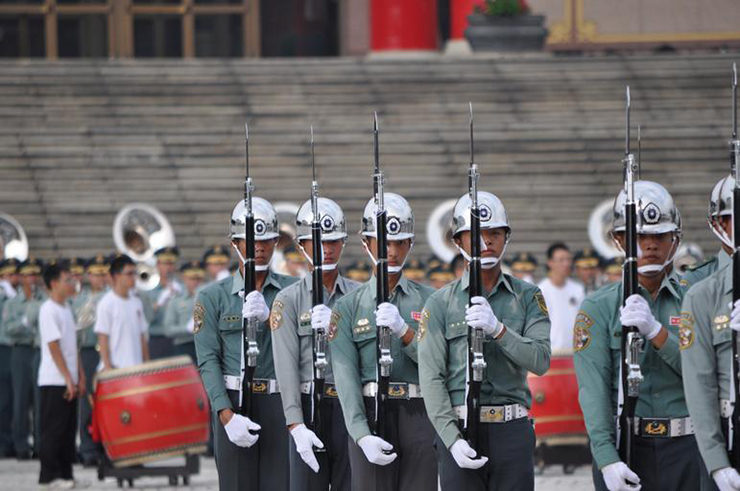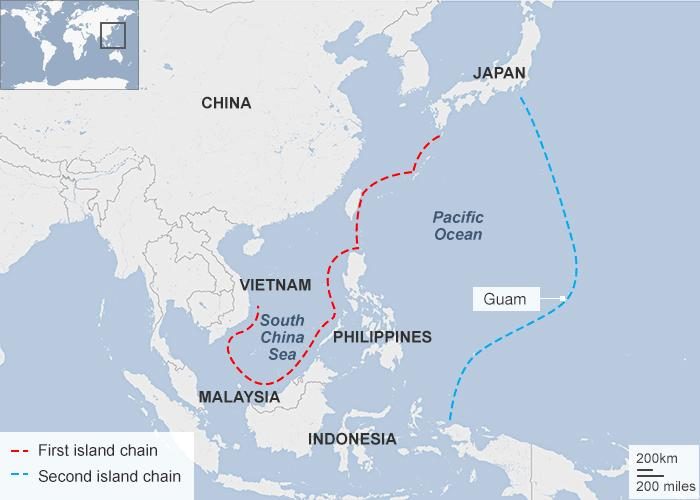
Taiwan military
Global military and political confrontation between two leading world powers (the USA and the PRC), which is shifting to the center of a new geopolitical game, is most clearly manifested in a sea strip, bordered, on the one hand, by the coast of China and, on the other hand, by the so-called "First island line".
The latter includes archipelagos of Japan, Taiwan and the Malay Archipelago. Control over the territories of these archipelagos allows the USA to solve the major strategic task of containment of distribution of Chinese military and political presence in the whole Region of the Indian and Pacific Oceans (RIPO).
The direct consequence of the covert and explicit rivalry between the major players is the fact that the most dangerous "hot zones" threatening world stability are located in this very strip. Of these zones the Korean peninsula and the South China Sea (alternating one another) have been in the center of attention over recent years.

© BBC
Taiwan, having an intermediate location between them, until recently looked like a political "quiet heaven". Just occasional events happening
on the island and around it revealed that the impression was deceptive. For it is exactly Taiwan that can top the most dangerous areas list in the American-Chinese confrontation. Judging by the latest events, it won't take long, apparently.
Here, it appears to be important to note principal differences between the real place of Taiwan and both Koreas in the world political arena, and the USA and China perceptions of these realities.
Both Koreas are independent states and full-fledged members of the UN. Being in a state of struggle over the influence on the Korean peninsula, the USA and the PRC have to accept the fact that here they are dealing with subjects of international law.
But Taiwan is totally different, often called as "specific" when describing its status. This term is rather a journalism, rather than international legal category. Although Taiwan (still self-called the Republic of China) has diplomatic relations with about 20 countries by now, it is not a UN member since 1971.
Since then, there is the People's Republic of China considering Taiwan as an integral part of the "uniform China" with the capital in Beijing. And this position is not just resolved to a political rhetoric, but reflected in the relevant laws of the PRC. In particular, since 2005 Beijing reserves the right to solve the Taiwan problem with "not only peaceful methods".
The respect for the principle of "uniform China" since 1979 has been declared also by the main geopolitical opponent of the People's Republic of China. But without explanation however of its understanding of the notion "uniform China".
Moreover, according to the law adopted in the same 1979 by the Congress of the USA (Taiwan Relations Act, TRA-1979), Washington considers acceptable only peaceful measures Beijing could take during the implementation of this principle. This fact nullifies the very fact of its recognition by the American officials. Last time the USA showed respect for this principle was during president Donald Trump's visit to the People's Republic of China on November 8-9.
But what does this American rhetoric really mean for Beijing? Almost nothing, as usually, which is clearly illustrated by two documents, published in December, 2017. It is about the new "National Security Strategy" signed by the American president and the law "On allocations for national military industry in 2018" adopted by the Congress.
The introduction to "NSS-2017″ declares the intention of the USA "to retaliate to the global growth of political, economic and military challenges", with China and Russia being the key originators.In section "Preserve Peace Through Strength", it is regretfully stated "broken hopes for liberalization and integration of China in the world order". The process of "military modernization and economic expansion" of the PRC is to a greater degree explained through access of Beijing to American advanced technologies and knowledge accumulated, in addition, "at the best American universities".
Two items appear quite remarkable in section "Strategy in the Regional Context" which starts (an it shall be highlighted) with RIPO. First, the intention to strengthen cooperation in the format of "FOUR" with the participation of the USA, Japan, Australia and India, as noted earlier
in NEO. Second, strengthening the existing military relations with Taiwan.
The last item is followed by a remark about "our policy" regarding the principle of the "uniform China". This remark looks absolutely ambiguous in the context of the "NSS-2017" in general and, in particular, in connection with mentioning of the law of 1979 in the same text.
Generally speaking, we could agree with the opinion that the documents like the NSS-2017, which are the product of the (legally binding, i.e. routine) activity of bureaucracy, should be regarded without excessive emotions, without giving them too much importance if it was not for the fact that the words of the "NSS-2017" on general matters concerning the topic of our interest, that is bringing the Taiwan issues to the forefront of the development of the American-Chinese relations, were immediately followed by specific "deeds" envisaged in the military budget of the USA for 2018.
It is about section 1259 ("Strengthening the defensive partnership between the USA and Taiwan") from the above document
of the Congress. This section, first, defines legislative and "sub-law" basis (including TRA-1979 and so-called "Six Assurances of Ronald Reagan") providing the leadership of the USA with sufficient freedom of action in the Taiwan issues.
Secondly, it defines various directions of the American-Taiwan interaction in the field of defense, planned for the next year, including "resuming" of joint Air Force exercises, mutual provision of "ports of call" etc.
It should be noted that there is nothing principally new in these two documents. The influential pro-Taiwan lobby has always been active in the USA (especially, in the Congress), and broad interaction between Washington and Taipei never stopped. The bilateral conference on cooperation between defense industry complexes which was held in the middle of October
in Princeton is its latest indication.
Nevertheless, extremely positive reaction of Taiwan in connection with emergence of both above documents cannot be ignored. In particular, the office of Taiwan president Tsai Ing-wen expressed gratitude to the leadership of the USA for inclusion of section 1259 in the text of the American budget
for the next year.
The negative reaction in the People's Republic of China to the new evidence of the increased role of Taiwan in confrontation
between Washington and Beijing was also quite expected. It is manifested not only in political rhetoric, but also in quite specific demonstrations. For example, large-scale military exercises of the Chinese People's Liberation Army (PLA) in the area in which Taiwan was the
geographical center.
The situation around Taiwan has been escalated with the tendency (which was also earlier mentioned
in NEO) on activation of Japan on Taiwan issues. As in the case of the USA, this tendency enjoys understanding from the Taiwan political elite, irrespective of the party affiliation of its certain sectors and despite claims of Taiwan for the Senkaku Islands (in any case, expressed in a much milder form than the leadership of the People's Republic of China does).
The latest evidence of mutual aspiration to strengthen the bilateral relations was a Memorandum of understanding in different spheres
of interaction at sea signed on December 20 in Taipei. Most remarkable here is rather the fact of negotiations and signing of a certain bilateral document by responsible representatives of Japan and Taiwan in view of no official diplomatic relations between them.
Several days earlier, again in Taipei, documents on interaction between the ruling parties of Japan and Taiwan were signed. The head of the delegation from the Liberal Democratic Party of Japan declared it was possible that his country would adopt a document similar to the American law
TRA-1979.In general, the situation unfolding around Taiwan looks all the less optimistic and it cannot be excluded that it will take the place in the regional game now given to the Korean peninsula and the South China See by the major players.
Reader Comments
to our Newsletter